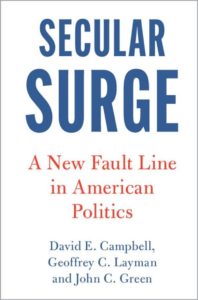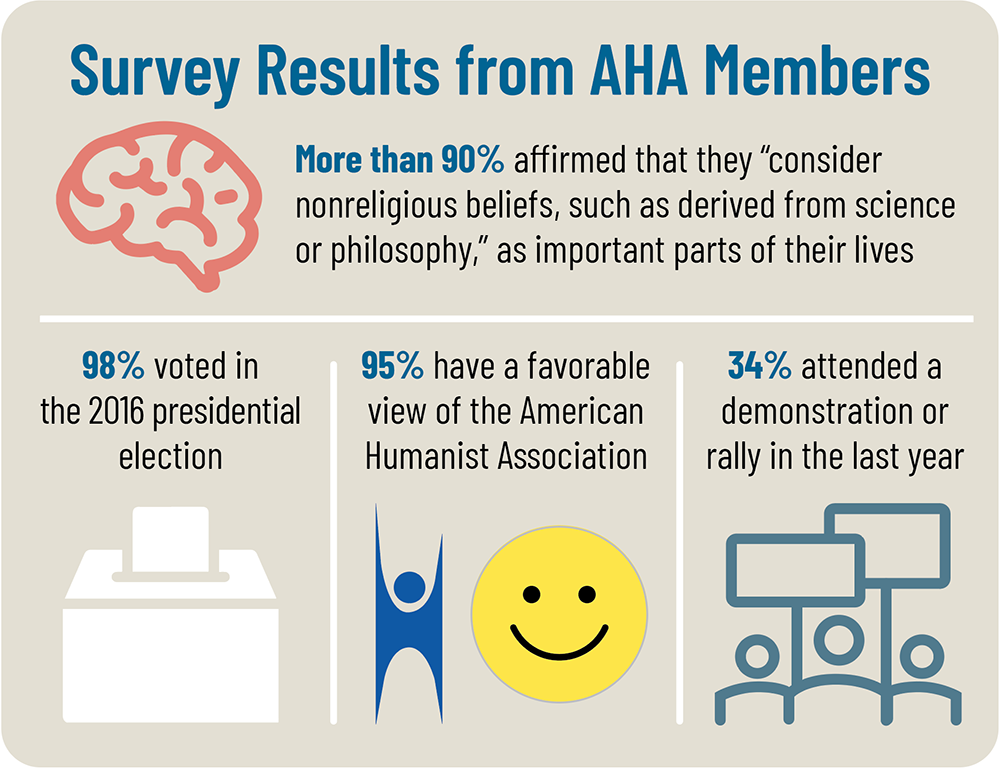Study Reveals More Defined Picture of Our Civically Active Humanist Community

Recently, I joined the authors of Secular Surge: The New Fault Line in American Politics for a panel discussion about their new book. Like any good student, I read the book in preparation, which led to too many annotations, notes, and rabbit holes of tangential research. If you give a mouse a cookie…
While normally, I’d write up a book review after such an event, I’d instead like to dive into the rich data these authors uncovered about the membership of the American Humanist Association (AHA) and our humanist community. Over the last 19 years, our former Executive Director Roy Speckhardt allowed the authors of Secular Surge to survey our members thrice: in 2002, 2011, and 2018. In 2017, the authors also conducted a “Secular America Studies” survey, meant to measure positivist nonreligious identity among the general American population. The longitudinal nature of the study of our membership, coupled with precise questions aimed at understanding what makes us tick (proverbially speaking), is research gold.
As humanists, we believe in letting the evidence guide us. Much of the data collected and analyzed for this project is new information to us and can be valuable for directing our work. Here are some of the highlights:
As expected, the majority of our members are white, college-educated, affluent, and over the age of sixty. When asked how we identify, we say we are humanists, atheists, agnostics, and secularists. And unsurprisingly, more than 90% of AHA members surveyed affirmed that they “consider nonreligious beliefs, such as derived from science or philosophy,” as important parts of their lives.
But these findings on our collective and individual identities aren’t the most informative data gathered in the book. The book accomplishes what many in our community have been asking for for years: a study that separates us from the catch-all category of the nonreligious. Campbell, Layman, and Green were able to distinguish between those who are generally not affiliated with a particular religion (“nones”) and those who have an affirmative identity as a humanist, freethinker, et cetera. What they found after they made this distinction is illuminating.

Historically, we’ve seen that “nones” aren’t very engaged in civic life, and humanists have had an inkling that we don’t really belong in that category, but we struggle to prove it. And generally, the data presented in Secular Surge reaffirms that belief; the authors demonstrate that nonreligious people are what they refer to as “civic dropouts:” nones aren’t engaged in politics, civic volunteerism, or other metrics of participation. Yet, humanists, freethinkers, and atheists don’t belong in this category at all. Instead, the authors found that our community is among the most civically active. For example, 34% of AHA members attended a rally or demonstration in the last year (remember that the survey was conducted pre-global pandemic).
When you separate us from those who select “none of the above” on religiosity or religious identity surveys, you see a different, more defined picture of our community. And we are—without a doubt—highly active in civic life.
- While nonreligionists are divided fairly as Democrats, Republicans, and Independents, those with a positivist identity as a humanist or freethinker are overwhelmingly Democrats;
- Secularists are more motivated by core values than by party loyalty;
- Much more than nonreligionists, we care deeply about social welfare and environmental protection;
- Humanists, freethinkers, atheists, etc. are more likely than nones to move in liberal political directions over time and people who hold democratic views are more likely to identify with our community over time; [1]
- 98% of AHA members surveyed voted in the 2016 presidential election.
And the most interesting piece of information I came across in the book: when the authors surveyed the delegates of the 2016 Democratic Convention and state democratic conventions in Iowa, Minnesota, Texas, and Washington state, our community made up the largest group of Democratic Party activists in each of those states when compared with religionists, nonreligionists, and religious secularists. And our community made up nearly half of the delegates at the Democratic National Convention.[2] We are incredibly active and overrepresented in democratic politics.
While I found fault with the book’s thesis—that our fast-growing and highly active minority group within a highly religious country is polarizing American politics—the data that got them to this questionable conclusion is valuable. Their original data sets (of which there were many) found that our community is spurred to action by deeply-held core values about the dignity of individuals, the separation of religion and government, and liberalism.
One final nugget of information: 95% of members surveyed have a favorable view of the American Humanist Association. I smiled when I read that. It means we’re doing something right. The evidence says so. But there is so much more to be done to fully leverage the civic engagement of our members. There are more rallies to be held, more senators to be called, and more voters to register. We have our work cut out for us.
[1] Note that the study doesn’t claim a causal relationship here.
[2] If you haven’t repressed memory of the 2016 election, you’ll remember that Bernie Sanders’ supporters were especially active at conventions, but, while the authors show that our community preferred Sanders, they don’t believe that accounts for our overrepresentation.
